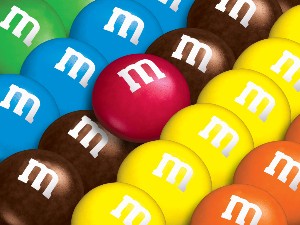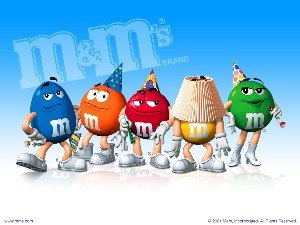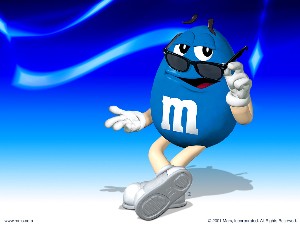Special Feature: Products Sally Recommends
In Praise of Blue M&Ms
Blue M&Ms taste better than the other colors.
 Strong words coming from a chef who is supposed to be making his living through the reputation of his taste buds & culinary prowess. This all started one day when I passed a bowl of M&Ms and thought, ‘Hmmm no more tan ones.’ I distinctly recall the color tan being part of the mix throughout my childhood, though I couldn’t remember exactly when it had been replaced by the vibrant and way too cool blue ones. Clearly I needed to mend this hole in my culinary memory. My wife, who is somewhat older than I, pleaded indifference, “I never paid attention to the colors”. Sacre bleu! (or blue, as the case may be) How can you not notice the color of your M&Ms? “And another thing,” my wife said to me as she crunched on a handful of M&Ms in bed, “you know how they say the chocolate doesn’t melt in your hand? Well, the candy coating does. It leaves colored spots all over your hands.” I hesitated to point out that I didn’t think many adults suffered that problem; I was after all getting into that bed with her, and wanted my fair share of the covers. I did tell her that the slogan in question, "The milk chocolate melts in your mouth—not in your hand"®, debuted in the initial TV advertising from 1954. After working a few more tidbits of M&Ms trivia into the conversation, she finally took the bait and asked why I had suddenly become so well versed in M&Ms lore. “I’m writing an article about M&Ms,” I explained. “What will your approach to this article be?” my wife inquired of me, in tones that suggested she considered my subject matter to be, shall we say, unique.
Strong words coming from a chef who is supposed to be making his living through the reputation of his taste buds & culinary prowess. This all started one day when I passed a bowl of M&Ms and thought, ‘Hmmm no more tan ones.’ I distinctly recall the color tan being part of the mix throughout my childhood, though I couldn’t remember exactly when it had been replaced by the vibrant and way too cool blue ones. Clearly I needed to mend this hole in my culinary memory. My wife, who is somewhat older than I, pleaded indifference, “I never paid attention to the colors”. Sacre bleu! (or blue, as the case may be) How can you not notice the color of your M&Ms? “And another thing,” my wife said to me as she crunched on a handful of M&Ms in bed, “you know how they say the chocolate doesn’t melt in your hand? Well, the candy coating does. It leaves colored spots all over your hands.” I hesitated to point out that I didn’t think many adults suffered that problem; I was after all getting into that bed with her, and wanted my fair share of the covers. I did tell her that the slogan in question, "The milk chocolate melts in your mouth—not in your hand"®, debuted in the initial TV advertising from 1954. After working a few more tidbits of M&Ms trivia into the conversation, she finally took the bait and asked why I had suddenly become so well versed in M&Ms lore. “I’m writing an article about M&Ms,” I explained. “What will your approach to this article be?” my wife inquired of me, in tones that suggested she considered my subject matter to be, shall we say, unique.
“That blue M&Ms taste better.” Clearly this confirmed her suspicions that she had indeed married a lunatic, and she rolled over and went to sleep.
 You must understand that I’m one of those people who like to think about what he’s eating. Commercial food making processes and its machinery fascinate me. (Acquiring this knowledge is how I plan to win if I ever get on Jeopardy!) What does M&M stand for? (Mars and Murrie, founders of the candy company.) How do they get that chocolate inside the candy shell? (the chocolate centers are formed in a machine, then undergo a process known as panning. A colored sugar and corn syrup mixture is added to the centers in a revolving pan. After some time, the moisture in the coating evaporates leaving an even layer of dry candy shell. This process is repeated several times until the M&M's have a thin, smooth shell of the desired thickness.)
You must understand that I’m one of those people who like to think about what he’s eating. Commercial food making processes and its machinery fascinate me. (Acquiring this knowledge is how I plan to win if I ever get on Jeopardy!) What does M&M stand for? (Mars and Murrie, founders of the candy company.) How do they get that chocolate inside the candy shell? (the chocolate centers are formed in a machine, then undergo a process known as panning. A colored sugar and corn syrup mixture is added to the centers in a revolving pan. After some time, the moisture in the coating evaporates leaving an even layer of dry candy shell. This process is repeated several times until the M&M's have a thin, smooth shell of the desired thickness.)
Even the trademark “m” on each candy has a story. Originally it was printed on the candies in black. In 1954 the color was changed to white. The machine that applies the “m” was designed especially for M&Ms, and is calibrated so the candy shell will not crack during the printing process.
Today there are over 400 million produced each day throughout the world. In the U.S. they are made in New Jersey and Tennessee. Sadly, for those of us who love food-factory tours, they do not offer any.
Corporate legend has it that during the Spanish civil war, Forrest Mars Sr. was in Spain and saw soldiers eating a candy-coated chocolate confection. He came back to America, perfected his recipe and began making M&Ms available to candy lovers in 1941. The original packaging was not today’s familiar brown pouch; until 1948 they came in a paper tube (what’s old is new - they now sell Mini M&Ms in plastic).
 The original colors were red, yellow, green, brown, orange and violet. (Whoa! Violet?) Yep, apparently back in 1949 tan had a better PR agent than it does today, because it knocked violet out of the line up. Tan managed to hang onto its place in the spectrum until 1995, when it was replaced by blue. In case you’re wondering, there is a specific amount of each color in the mix; for the milk chocolate candies (since 2000 they are no longer called “plain” – I know it always bothered me that I was eating candy marketed as “plain”) it is 30% brown, 20% each of yellow and red and 10% each of orange, green and blue. Even though M&Ms didn’t use the particular red food color that was being blamed for the ills of many children, from 1976-1987 red was removed from the mix “to avoid consumer confusion”.
The original colors were red, yellow, green, brown, orange and violet. (Whoa! Violet?) Yep, apparently back in 1949 tan had a better PR agent than it does today, because it knocked violet out of the line up. Tan managed to hang onto its place in the spectrum until 1995, when it was replaced by blue. In case you’re wondering, there is a specific amount of each color in the mix; for the milk chocolate candies (since 2000 they are no longer called “plain” – I know it always bothered me that I was eating candy marketed as “plain”) it is 30% brown, 20% each of yellow and red and 10% each of orange, green and blue. Even though M&Ms didn’t use the particular red food color that was being blamed for the ills of many children, from 1976-1987 red was removed from the mix “to avoid consumer confusion”.
Peanut M&Ms didn’t come onto the scene until 1954, and at that time they were all brown. 1960 saw the addition of red, green, and yellow. Orange was added to the mix in 1976 but was replaced with blue just nine years later. As with the milk chocolate candies, there is a specific amount of each color in the peanut mix: 20% each of brown, yellow, red and blue and 10% each of green and orange. (Hey, wait a minute – you get more blue ones in the peanut? I don’t like the peanut. Not fair!)
Apart from an occasional change in color, M&Ms remained a rather consistent product until the 1980’s. In a decade marked by astonishing changes in the world, M&Ms made a few changes of their own. New “seasonal color blends” were introduced – red & green for Christmas; red, pink and white for Valentine's Day; pastels for Easter; orange & black for Halloween.
 The era of change continued into the 1990’s with the introduction of M&M's Peanut Butter Chocolate Candies, M&Ms Almond Chocolate Candies and M&M's Crispy Chocolate Candies. Blue lovers rejoice – each new flavor includes 16.6%-20% of your favorite color. Which leads me to ask-why only 10% in the plain? (Excuse me, I mean milk chocolate candies. Hey, I still refer to new CD’s as “albums”.) M&M's Chocolate Mini Baking Bits were also added to the brand portfolio. (I always found adding regular M&Ms to my cookies to be completely satisfying; I don’t think the mini baking bits taste the same as regular M&Ms and I suspect it has to do with the ratio of chocolate center to candy shell. At least that argument sounds somewhat scientific, a little better than “because I said so”, so I’m sticking with it.)
The era of change continued into the 1990’s with the introduction of M&M's Peanut Butter Chocolate Candies, M&Ms Almond Chocolate Candies and M&M's Crispy Chocolate Candies. Blue lovers rejoice – each new flavor includes 16.6%-20% of your favorite color. Which leads me to ask-why only 10% in the plain? (Excuse me, I mean milk chocolate candies. Hey, I still refer to new CD’s as “albums”.) M&M's Chocolate Mini Baking Bits were also added to the brand portfolio. (I always found adding regular M&Ms to my cookies to be completely satisfying; I don’t think the mini baking bits taste the same as regular M&Ms and I suspect it has to do with the ratio of chocolate center to candy shell. At least that argument sounds somewhat scientific, a little better than “because I said so”, so I’m sticking with it.)
As I said before, tan’s popularity finally ran out in 1995. However, instead of an arbitrary corporate decision, we candy lovers ourselves were asked to vote for the new color. Our choices included blue, pink, purple or no change. M&Ms says more than 10 million votes were cast, with blue garnering a majority 54%. God bless America – democratic right down to choosing our candy colors!
I suspect people in marketing are naturally restless; either that or they have a very short attention span. Either way the marketing folks at M&Ms have been playing color games with us in the new millennium. During 2001 and 2002 M&M's offered people from over 200 different countries the chance to vote on a new color to be added into the mix. The Global Color Vote asked us to choose (worldwide democracy-how nice) between purple, aqua and pink (notice how this time “no change” wasn’t an option? Getting a little pushy, aren’t they?) Purple won with 41% of the vote (barely a contender for the massive popularity of blue) and was added to the mix for a limited time (while blue is still in the mix…)
Just in case we were getting too comfortable with all this “color democracy”, in 2004 they took away all our beloved colors. For two and a half months, only packages containing black & white candies were available. It was a black time (no pun intended) for M&Ms lovers. Even I was affected, left feeling strangely blue (OK that was intended). To my dying day I will assert that the black & white mix had an “off” flavor. Of course, the company asserts that “there is no difference in taste due to the different colors.” I disagree.
Blue M&Ms taste better.
© 2005 Glenn E. Burgess
Glenn E. Burgess cooks as a personal chef on
Note: This information was accurate when it was published. Please be sure to confirm all rates and details directly with the businesses in question before making your plans.



